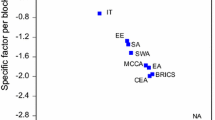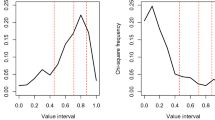Abstract
The human development index (HDI) rankings have provided a referenced measure for people to choose a country in which to travel or live. This paper employs a superefficiency model to evaluate the rationality of the HDI rankings of 19 evaluated OECD countries in 2009. Compared to the HDI rankings, the efficiency rankings measured by the super-efficiency model have the following two advantages: (1) they consider the inputs that are used to generate the indicators for constructing the HDI, and decide the weights of inputs and outputs endogenously; (2) the input slacks measured by the super-efficiency model can evaluate whether the inputs are over-used and provide the improvement path of each country’s input variables. Empirical result shows that approximately 75 % of the evaluated countries had rather different results in the efficiency rankings and the HDI rankings. Additionally, the input slack shows that roughly 70 % of sample countries over-used their capital per labor relative to their existing outputs (or the HDI).
Similar content being viewed by others
Notes
Even though there are weight constraints in DEA models, the optimal weights of inputs and outputs are also determined endogenously.
The use of the HDI is to rank countries or regions by level of human development: low, medium, and high.
This paper abandons the other indicator used for constructing the HDI-literacy rate, because the rates have no prominent difference among the 19 sample countries.
For more details on the criticisms on HDI, see Kovacevic (2011).
While Ülengin et al. (2011) employ super-efficiency model and artificial neural networks to improve the original HDI, the inputs (e.g., efficiency enhancers, and innovation and sophistication factors) used in their super-efficiency model are more likely to be classified as outputs, not inputs.
Even for the new method developed for calculating HDI after 2010, the HDI is constructed by geometric mean of the three normalized indices.
For more details on the utility of super-efficiency model, see Andersen and Petersen (1993).
While the UNDP has used a new method to measure the HDI since 2011, the latest data sets are available in 2009.
We have tried to search the missing data from other dataset or the statistical data of individual countries; however, the result is disappointed. In addition, some previous studies employing OECD countries as sample objects to conduct relative empirical analysis have also faced the problem of missing data (e.g., Dreger and Reimers 2005; Baltagi and Moscone 2010). We appreciate the suggestion of one anonymous reviewer.
As mentioned early above, our main aim is not to cover complete inputs and outputs in the super-efficiency model. Thus, we choose only two crucial inputs in the super-efficiency model.
References
Alkire, S. (2002). Dimensions of human development. World Development, 30(2), 181–205.
Allen, R., Athanassopoulos, A., Dyson, R., & Thanassoulis, E. (1997). Weight restrictions and value judgments in data envelopment analysis: evolution, development and future directions. Annals of Operations Research, 73, 13–34.
Al-Shammari, M. (1999). A multi-criteria data envelopment analysis model for measuring the productive efficiency of hospitals. International Journal of Operations & Production Management, 19(9), 879–897.
Anand, S., & Sen, A. (1994). Human development index: Methodology and measurement. New York: UNDP.
Andersen, P., & Petersen, N. C. (1993). A procedure for ranking efficient units in data envelopment analysis. Management Science, 39, 1261–1264.
Baltagi, B. H., & Moscone, F. (2010). Health care expenditure and income in the OECD reconsidered: Evidence from panel data. Economic Modelling, 27(4), 804–811.
Banker, R. D., Conrad, R. F., & Strauss, R. P. (1986). A comparative application of data envelopment analysis and translog methods: An illustrative study of hospital production. Management Science, 32, 30–44.
Becker, G. S. (1964). Human capital. New York: Columbia University Press.
Blaug, M. (1976). An introduction to the economics of education. Harmondsworth: Penguin.
Charnes, A., Cooper, W., & Rhodes, E. (1978). Measuring the efficiency of decision making units. Europe Journal of Operational Research, 2, 429–444.
Cherchye, L., Ooghe, E., & Van Puyenbroeck, T. (2008). Robust human development rankings. Journal of Economic Inequality, 6(4), 287–321.
Coelli, T. J., Rao, D. S., O’Donnell, C. J., & Battese, G. E. (2005). An introduction to efficiency and productivity analysis. Berlin: Springer.
Desai, M. (1991). Human development: Concepts and measures. European Economic Review, 35, 350–357.
Despotis, D. K. (2005a). Measuring human development via data envelopment analysis: The case of Asia and the Pacific. Omega, 33(5), 385–390.
Despotis, D. K. (2005b). A reassessment of the human development index via data envelopment analysis. Journal of the Operational Research Society, 56, 969–980.
Dreger, C., & Reimers, H. E. (2005). Health care expenditures in OECD countries: A panel unit root and cointegration analysis. International Journal of Applied Econometrics and Quantitative Studies, 2(2), 5–20.
Emrouznejad, A., Barnett, R. P., & Tavares, G. T. (2008). Evaluation of research in efficiency and productivity: A survey analysis of the first 30 years of scholarly literature in DEA. Socio-Economic Planning Sciences, 42(3), 151–157.
Gormely, P. J. (1995). The human development index in 1994: Impact of income on country rank. Journal of Economic and Social Measurement, 21, 253–267.
Grimm, M., Harttgen, K., Misselhorn, M., & Klasen, S. (2008). A human development index by income groups. World Development, 36(12), 2527–2546.
Jorgenson, D. (2009). The economics of productivity. An Elgar reference collection. Cheltenham: UK.
Kovacevic, M. (2011). Review of HDI critiques and potential improvements (p. 33). UNDP: Human Development Research Paper.
Lozano, S., & Gutiérrez, E. (2008). Data envelopment analysis of the human development index. International Journal of Society Systems Science, 1(2), 132–150.
Mahlberg, B., & Obersteiner, M. (2001). Remeasuring the HDI by data envelopment analysis. Interim report, IR-01-069. Laxenburg, Austria: International Institute for Applied Systems Analysis (IIASA).
Malul, M., Hadad, Y., & Ben-Yair, A. (2009). Measuring and ranking of economic, environmental and social efficiency of countries. International Journal of Social Economics, 36, 832–843.
McGillivray, M. (1991). The human development index: Yet another redundant composite development indicator? World Development, 19(10), 1461–1468.
Mostafa, M. M. (2007). Evaluating the comparative market efficiency of top listed companies in Egypt. Journal of Economic Studies, 34(5), 430–452.
Musai, M., & Ghorbani, P. (2008). Effect of factors affecting demand for inbound tourist travel to Iran after the Islamic Revolution until 2004. Proceedings of the National Conference on Investment in Tourism Development. Tehran: Tarbiat Modarres University.
Musai, M., Mehrara, M., Nemati, S. F., & Tak, M. N. (2011). Demand for travel to Iran and human development index. European Journal of Social Sciences, 25(1), 14–20.
NÜbler, I. (1995). The human development index revisited. Intereconomics Review of European Economic Policy, 30(4), 171–176.
Ogwang, T. (2000). Inter-country inequality in human development indicators. Applied Economics Letters, 7(7), 443–446.
Osberg, L., & Sharpe, A. (2003). Human well-being and economic well-being: What values are implicit in current indices? Centre for the study of living standards research report, 04. Ottowa: Centre for the Study of Living Standards.
Pan, S. C., Liu, S. Y., Peng, C. J., & Wu, P. C. (2011). Local governments’ efficiency evaluation: Consideration of undesirable outputs and super-efficiency. African Journal of Business Management, 5(12), 4746–4754.
Panigrahi, R., & Sivramkrishna, S. (2002). An adjusted human development index: Robust country rankings with respect to the choice of fixed maximum and minimum indicator values. Journal of Human Development, 3(2), 301–311.
Raab, R., & Habib, E. (2007). A productivity growth accounting approach to the ranking of developing and developed nations. The International Journal of Accounting, 42, 396–415.
Sagar, A. D., & Najam, A. (1998). The human development index: A critical review. Ecological Economics, 25, 249–264.
Scheel, H. (2000). EMS: Efficiency measurement system user’s manual. Version 1.3.
Sen, A. (2000). A decade of human development. Journal of Human Development, 1(1), 17–23.
Steinmann, L., & Zweifel, P. (2003). On the (in)efficiency of Swiss hospitals. Applied Economics, 35(3), 361–370.
Taner, M. T., Sezen, B., Alpkan, L., & Aren, S. (2010). Recomputation of UNDP’s HDI rankings by data envelopment analysis. St. Petersburg, Russia: International Strategic Management Conference.
Tavares, G. (2002). A bibliography of data envelopment analysis (1978–2001). Rutcor Research Report, RRR 01–02, January.
Ülengin, F., Kabak, Ö., Önsel, S., Aktas, E., & Parker, B. R. (2011). The competitiveness of nations and implications for human development. Socio-Economic Planning Sciences, 45(1), 16–27.
UNDP (United Nations Development Program). (2008). Human development reports, http://hdr.undp.org/en/humandev/.
Wolff, H., Chong, H., & Auffhammer, M. (2009). Human development index: Are developing countries misclassified?. Milwaukee, Wisconsin: Agricultural and Applied Economics Association Annual Meeting.
Zelenyuk, V., & Zheka, V. (2006). Corporate governance and firm’s efficiency: The case of a transitional country Ukraine. Journal of Productivity Analysis, 25(1–2), 143–157.
Zhu, J. (1996). DEA/AR analysis of the 1988–1989 performance of the Nanjing Textile Corporation. Annals of Operation Research, 66, 311–335.
Author information
Authors and Affiliations
Corresponding author
Rights and permissions
About this article
Cite this article
Wu, PC., Fan, CW. & Pan, SC. Does Human Development Index Provide Rational Development Rankings? Evidence from Efficiency Rankings in Super Efficiency Model. Soc Indic Res 116, 647–658 (2014). https://doi.org/10.1007/s11205-013-0285-z
Accepted:
Published:
Issue Date:
DOI: https://doi.org/10.1007/s11205-013-0285-z




